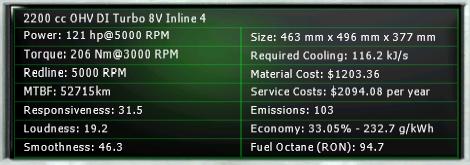Page 1 of 1
FMU Showroom/Museum (engines)

Posted:
Sun May 04, 2014 6:25 amby Manche
First let me start with a motor balck that is a master in economy. runs on 95 oct fuel, and pulls great economy despite being a pushrod engine and no quailty sliders touched.

Re: FMU Showroom/Museum (engines)

Posted:
Sun May 04, 2014 2:22 pmby 07CobaltGirl
Turbo and pushrod using a 5000 rpm redline on a 2.2L engine? Well that explains the 121 hp, since you're using a tiny turbo to spool before 4000 rpm, or you're not getting any benefit at all from the turbo. And 33% isn't really all that economical. FYI, my car IRL is a 2.2L N/A engine with more than 121 hp, a 6500 redline, and it gets 35 mpg. Of course, it isn't DI or OHV either.

Re: FMU Showroom/Museum (engines)

Posted:
Sun May 04, 2014 4:13 pmby Slim Jim
Fuel economy (your 35mpg) and engine efficiency (his 33%) are related, but not comparable. For instance, that engine in a heavy car with poor aerodynamics might only get 20mpg, but in a light car with low drag might get 40mpg.
As a low-cost engine with good torque, I'd say that's a decent start. There are similarly-sized naturally-aspirated engines out there with more power, but it looks pretty tractable.
Re: FMU Showroom/Museum (engines)

Posted:
Sun May 04, 2014 4:32 pmby Manche
This is the Typhoon 337 block, this is the forefather of all FMU V8s with a long stroke namanges to get a reasonable economy for its size enabling a big 1400kgs sedan to make 17.5 MPG.
Later the engine got a revised little brother with the same name with 2 stroke available 80 and 90 mm. and thanks to the experiment of hotrodders it was discoivred the engine can accept safely 94mm pistons producing a prcatical maximum of 377 cui or 6167cc
the shorter blocks can either be 3937, 4441, 4467 or 4997 cc the 2 later options are done with the big pistons
(also I managed to tune that engine for my last post to 130 hp and 36.77% economy)
Re: FMU Showroom/Museum (engines)

Posted:
Mon May 05, 2014 6:58 amby KD14
I made a quick tune to your engines.
The hurricane, slightly more expensive but it was necessary, 50k MTBF is really not enough for an economic 2014 car. I changed the bore and stoke to gain more MTBF, now it has 77K. I optimized the turbo sizes and gained back the efficiency i lost from the stroke change + ~1.5% more. Same power, larger power band.
The Typhoon, same price better everything.
Re: FMU Showroom/Museum (engines)

Posted:
Mon May 05, 2014 7:25 amby Manche
Thanks! though those are ancient RL engines revised hence the long stroke
the thyphoon is based on ford's big flathead engine
and the hurricane in the jeep hurricane, the 2.2 version
Re: FMU Showroom/Museum (engines)

Posted:
Mon May 05, 2014 8:14 amby KD14
Its much better to do an automation engine that meets a real engine output rather then doing a real engine made in automation

Re: FMU Showroom/Museum (engines)

Posted:
Tue May 06, 2014 3:38 amby Manche
KD14 wrote:Its much better to do an automation engine that meets a real engine output rather then doing a real engine made in automation

speaking of that I will make my starting engine a 4 bager 92 by 92, perfectly square
Re: FMU Showroom/Museum (engines)

Posted:
Tue May 06, 2014 11:02 amby KD14
You should tune the bore and stroke according to your selected rpm limit, in a way that the bottom end parts will stress just after the selected rpm. By doing that you get the most efficient bore and stroke without causing stress.
Re: FMU Showroom/Museum (engines)

Posted:
Tue May 06, 2014 9:50 pmby Manche
KD14 wrote:You should tune the bore and stroke according to your selected rpm limit, in a way that the bottom end parts will stress just after the selected rpm. By doing that you get the most efficient bore and stroke without causing stress.
I normally take all that into account when I make scenario engines
Re: FMU Showroom/Museum (engines)

Posted:
Wed Jul 02, 2014 12:35 pmby Manche
The son of the founder (a short flamboyant temperamental man) had a fit of rage a few month after he took charge of the company after the death of his father.
The result of that fit of rage was a draft of the hurricane engine block with some markings that despite their emotionality, it gave clear instruction to the engineers: move the camshaft to the cylinder head, and bring than the stroke..
The result was the HBL200 an engine that still in one form or another remains in service witha wide variety of toppings.


